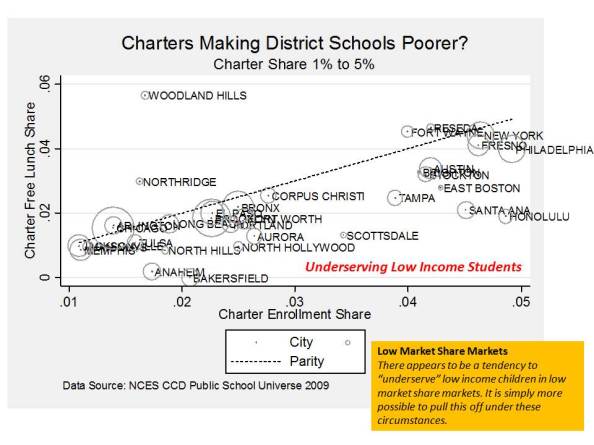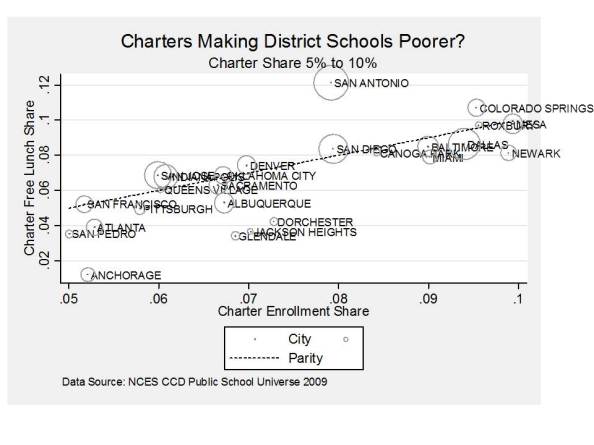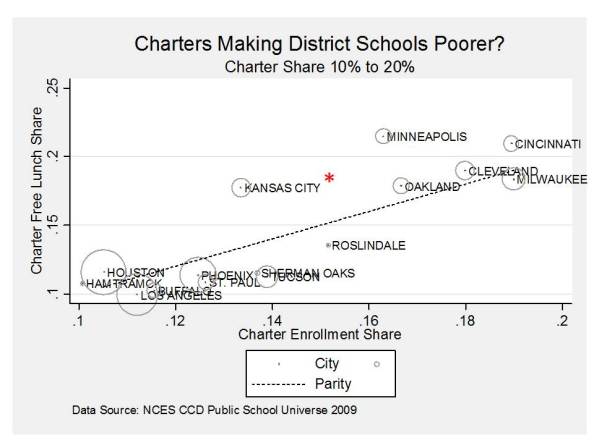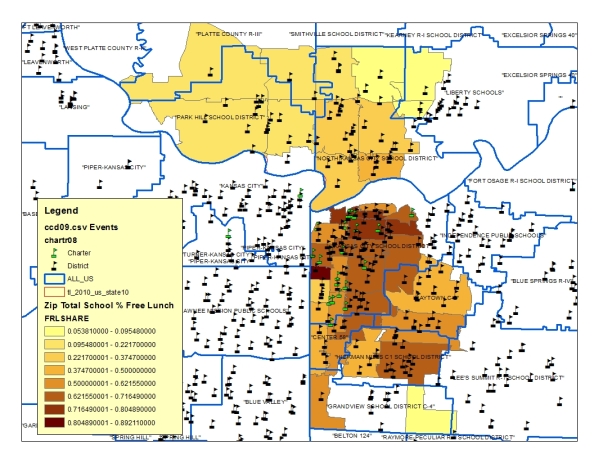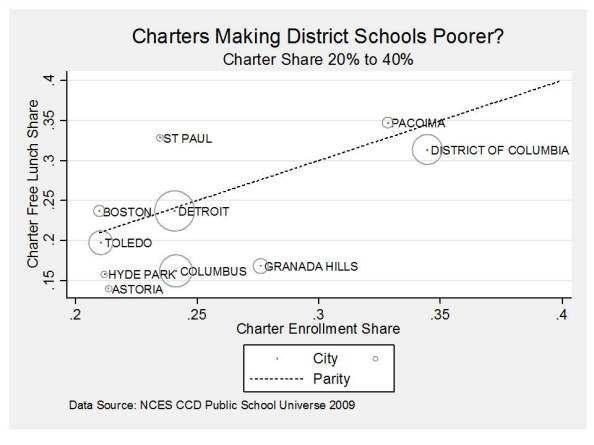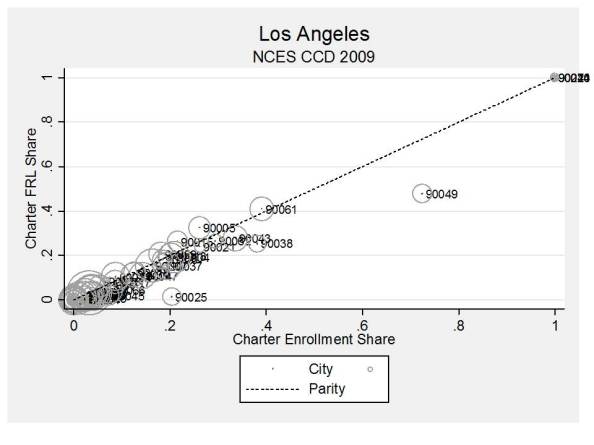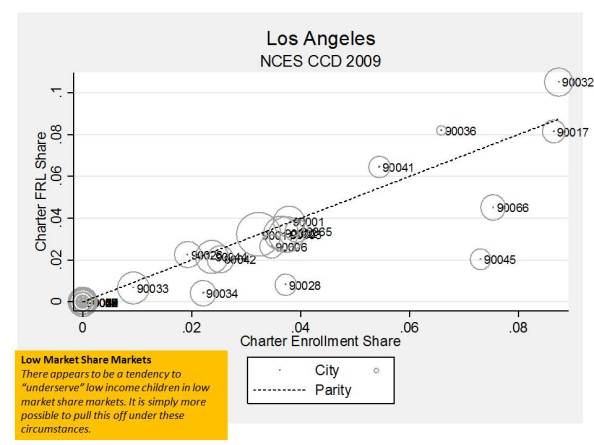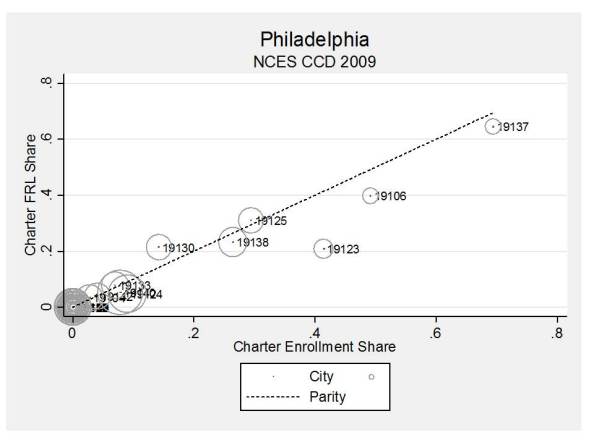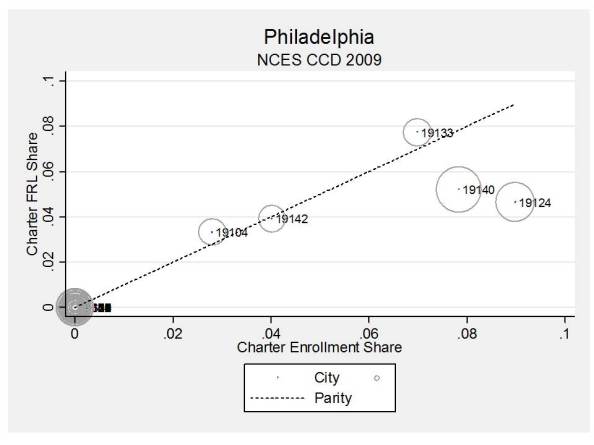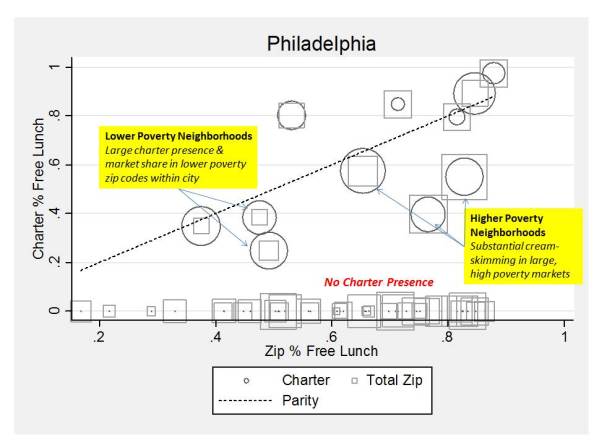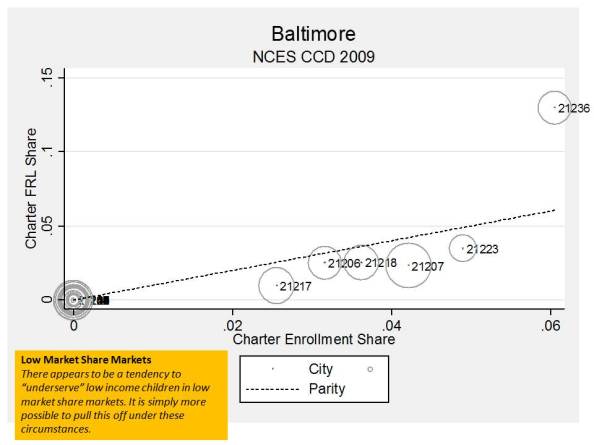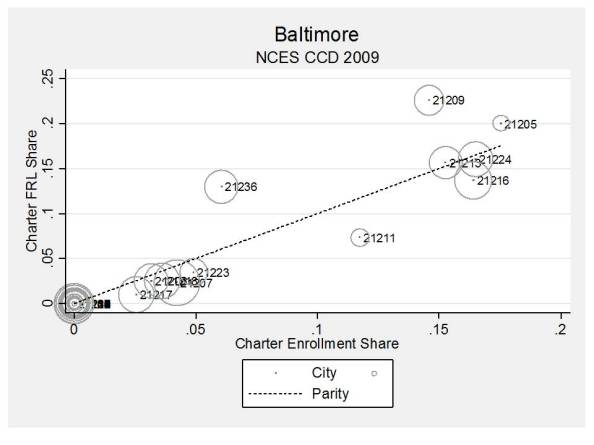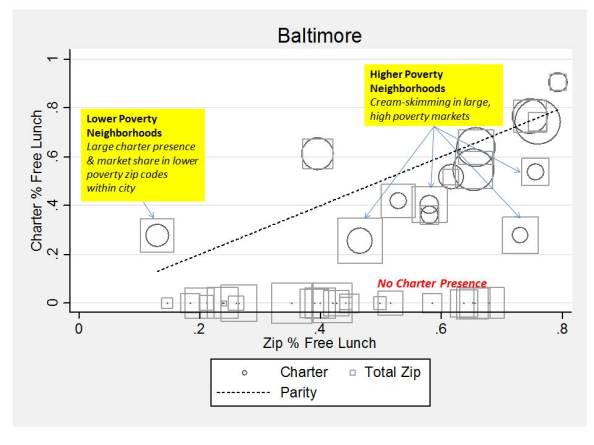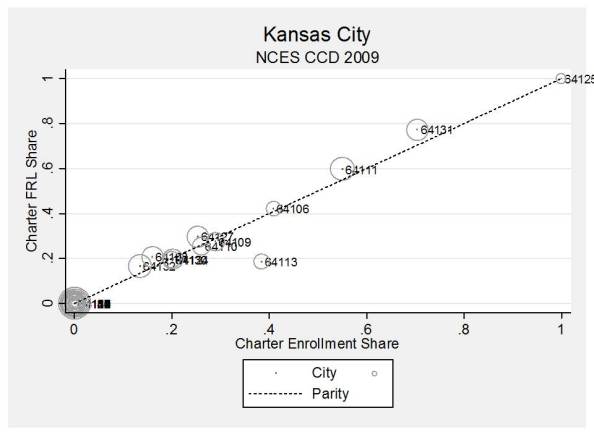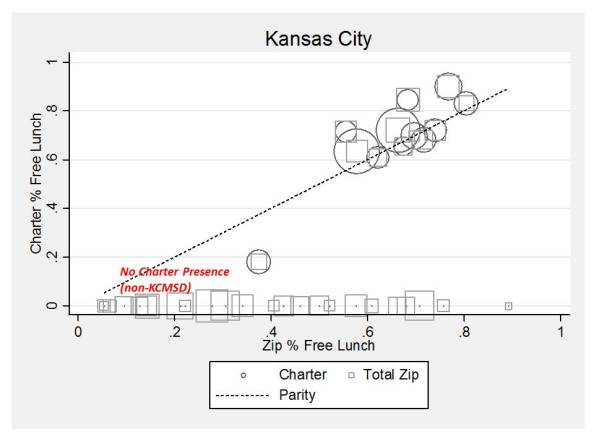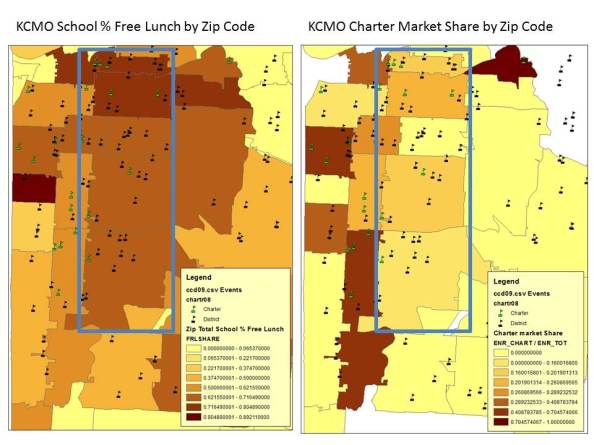Parsing Poverty: Charter Market Segmentation Across & Within U.S. Cities
Late Thursday, I posted a follow up on the distribution of children with disabilities by disability classification across charter and district schools in New Jersey and Pennsylvania. This post explores the distribution of children who qualify for free lunch in charter schools and district schools within the city limits of major cities. Note that the unit of analysis – the charter market, per se – that I am using here is the “city limits” and all schools – charter and district that lie within specific large central cities (urban centric locale code 11). Why does this matter? And why do I do it this way? One reason is data convenience. Another is that it’s important to recognize that many U.S. Cities are carved into multiple school districts, often times relating to a long history of housing and school segregation. I’ll provide some Kansas City examples below. In other words, the traditional district system already creates some artificial boundaries of segregation, onto which the charter system is now being superimposed.
Again, in this post, I’m focusing on low income children. When it comes to low income children, Charter schools in many settings do tend to serve smaller shares of the lowest income children, leaving larger shares behind in district schools. Here, my interest is in evaluating major urban centers across the country to determine the extent to which these patterns are systematic. And also, the extent to which these patterns vary by charter market share. I believe I’ve mentioned on previous posts that it seems most likely that charter schools can maintain a cream-skimmed population when charters generally have smaller market share. That is, when there’s enough cream to go around.
So, here goes… using data from the 2009 Common Core (there were more gaps in free lunch and enrollment data in 2010) of Data from NCES.
Visualizing Market Segmentation
This first figure conveys my strategy for my first cut comparisons of charter market segregation by student low income status. Imagine for any given city, there are a certain number of total enrolled students and a certain number of low income enrolled students. If charter schools in the aggregate in that city are serving an equitable share of low income children, the share of low income children served should match the overall market share. That is, if charter schools serve 10% of all children enrolled in schools in the city, then charter schools should also be serving 10% of the low income children. One can graph cities accordingly.
When charters – or the citywide charter sector as a whole are operating at parity – they will fall along the red dotted diagonal line. But, when charters are serving a lower share of low income children, they will fall below the line. When they are serving a higher share than the city schools (which may include multiple districts/entities), they will fall above the line.
Major U.S. Markets
Here, I review the charter market share and free lunch shares for small market share cities, medium market share cities, and large market share cities.
An important clarification is in order with regard to certain cities like New York and Boston. In the NCES Common Core, these cities are actually broken up into many separate cities. Boston is broken up into Boston (central city), Dorchester, East Boston, etc. New York is broken up into Manhattan/New York, Bronx, Brooklyn and Queens is broken up into separate cities (essentially neighborhoods). As such, they each appear as smaller markets than one might expect.
Small Market Share
This first figure shows markets with relatively small charter market share – less than 5% of children enrolled in charters. Circle size indicates the aggregate enrollment across charter and district schools – or market size. In most of these markets including the Bronx, New York (Manhattan) and Philadelphia the charter free lunch share is below parity. This means that these charters are leaving behind more lower income kids than they are taking in.
Medium Market Share
In lower middle-market cities, things seem to even out a bit, but many are still below the parity line, including Newark, which I have pointed out on many occasions. San Antonio charters have a higher free lunch share than the districts serving San Antonio.
Large Market Share
In larger market share cities there seems to be even greater parity, and in Minneapolis and Kansas City it would appear that the charters on average are serving more lower income children than the district schools within the city limits. But, some caveats are in order here…
Kansas City provides an interesting case where these descriptions are perhaps a bit deceiving. Kansas City – through strategic housing planning and school district boundary planning - was carefully carved into racially identifiable neighborhoods throughout the early half of the 20th century (and then some – actually as late as 2007). If we look at all zip codes within the broad city limits (below) we include several school districts. Among these, we include the central city district KCMSD, but we also include the predominantly white, higher income communities north of the river. Notably, as a function of the state’s original charter statute, there are no charters north of the river (as they were only permitted in KCMSD and St. Louis originally). So, this comparison needs some tweaking and more fine grained local analysis – like that which follows.
Finally, here’s a snapshot of the largest market share cities. Notably, even in Columbus Ohio and Washington DC, with relatively large total market size and large market share, charters seem to be under-serving the lowest income students. With such large market share, one can expect that this has a significant adverse effect on district schools.
Digging into the Cities
One can take the same approach and bring it down to the zip code level within cities. Now, because of data constraints, all of these analyses focus on school enrollments of schools that happen to be located in a particular zip code. I’m not able to look, for example, at the zip codes from which the students actually come to these schools. So, one must assume there to be some fuzziness around the zip code boundaries. That some lower income students do travel outside of their zip code to attend charter schools.
Los Angeles
Across all zip codes in Los Angeles, many operate at parity, but in some cases, charters are clearly underserving low income students at least compared to district schools in the same zip code.
Zooming in on zip codes with charter market share below 10%, we can see that there are actually quite a few where low income populations are underserved, and not so many where they are significantly overserved, per se.
Philadelphia
Philadelphia displays a similar pattern across all zip codes, with low income children significantly underserved in some markets including those with relatively high charter market share (over 40%).
Focusing on zip codes with smaller market share, we see that some particularly large markets have charter schools that are underserving low income children.
This next figure paints an alternative picture of charter market segmentation in Philadelphia. Here, I do the more typical relationship between total zip code % free lunch and charter % free lunch. But, I also include all of the zip codes that don’t have any charters. AND, I plot as squares the overall market size (total enrollment) and as circles the charter market size (charter enrollment). Yeah… way to much for any one graph… but bear with me.
So, if there is a large square, with a small circle in it, that’s a high total enrollment zip code, with relatively low charter enrollment. If there’s a smaller square with large circle, that’s a smaller zip code market with a large charter enrollment. All of those squares along the bottom are zip codes with no charter market share at all. In Philadelphia, there exist several high poverty zip codes with no charters. And there are some large high poverty zip codes with large charter market shares – BUT… where those charters are underserving low income children.
Perhaps even more interesting but not surprising is that in this predominantly low income city, there are three relatively large markets, with very large charter market share, that are NOT zip codes with high low income share. That is, the charter sector has grown and taken large market share in what might generally be considered more advantaged zip codes.
Baltimore
Here’s Baltimore (I always get asked to include Baltimore… so here it is). And Baltimore’s low charter market share zip codes display what seems to be a typical pattern, with most having charter sectors that serve fewer than expected low income children (again, those qualified for free lunch).
Larger market share zip codes are more of a mixed bag in Baltimore, as one might expect.
As with Philadelphia, we see that some charters have established in generally lower poverty zip codes, but in this case, the charters are serving a lower income population than the other schools around them. But, in the higher poverty zip codes, charters tend to be serving lower poverty populations. And this includes several of the larger markets and includes those with particularly large charter market share. Again, my policy concern here is the effect that this has on the district schools which must serve those not siphoned off into charters. And this does not include the special education or ELL sorting, which in most cases I’ve evaluated thus far tends to be more extreme.
Kansas City
I close this one out with Kansas City. Recall that it appeared that charter schools in Kansas City actually serve a larger share of low income kids than district schools in the city. But, that finding was complicated by the fact that the city limits actually include what many might consider to be the equivalent of suburban districts (the ones presently fighting in court against accepting KCMSD students on interdistrict transfer – another story for another day). For the most part, across all KC zip codes that have charters, charter enrollment share and free lunch share are in line – but for 64113.
Citywide, charter market shares are concentrated in higher poverty zip codes, but for one, again, as a function of district organization and the original charter statute.
But even Kansas City has some issues regarding the extent to which charter schools actually reach the lowest income neighborhoods in the city. In fact, a really cool Kauffman Foundation (Charter Advocates for the most part) report about a year ago pointed out how charters had largely established around the edges of the poorest neighborhoods but were not embedded in those communities. I discussed that report here: http://schoolfinance101.wordpress.com/2010/10/30/biddle-me-this-or-flunkout-nation/
The maps above more or less reinforce the Kauffman report findings. On the left are zip code free lunch shares, showing the core of higher poverty up through the center of the city (blue box). Charter schools are green, district schools black. Note that charters are mostly lined up along the western edge of the blue box, and to the north toward downtown. And on the right we see that charter market shares are largest to the west of the low income core, but not within it. This is one case, however, where I’d love to have the locations of residence for the students, to see how many cross over from the poorer zip codes to attend the charters. That said, the previous figures indicate that the low income concentrations in those charters resemble their surrounding schools in the same zip code – not the low income concentrations of the poorer zip codes to the east.
Closing Thoughts
So, this brings me back to the point I’ve been reiterating over and over these past several weeks. We need to figure out how all of this stuff fits together. From a policy perspective, we need to concern ourselves with the overgrowth of schools that do not serve representative populations in part because of the effect those schools have on the others around them. Indeed, it may not be wise to force some of these schools to take on students that they simply aren’t capable of handling. As I’ve said before, perhaps some of them do well with their select population because of their select population, and perhaps they’ve learned to work well with that population.
Allowing or even encouraging an unfettered parasitic decomposition of urban schooling is not a reasonable policy solution as it will ultimately harm large numbers of the lowest income, disabled and non-English speaking students disproportionately left behind. Some market segmentation is tolerable, and existed long before charter expansion became a primary cause.
Finally, there’s also that pesky concern I have about shifting larger and larger shares of children into schools where they and their parents may be unknowingly compromising constitutional and statutory rights. I am especially concerned given that charter school market shares tend to be largest and expanding most quickly in urban settings serving low income and minority children. As such, we are moving toward a system where low income and minority children are more likely than their white suburban peers to be attending a school that calls itself public, but one in which those students may be sacrificing constitutional and statutory rights they would otherwise have in a real public institution.
Again, this is not to say that charter operators are generally out to deprive kids of rights. But rather, that legal protections for these children are being quietly eroded by the emerging ambiguities of the “public until it’s legally convenient to argue otherwise” charter sector. We need to pay attention to this erosion of rights, and its disproportionate impact on low income and minority children.
The bright spot (he opined cynically) in the figures above is that in most charter markets – which do tend to be low income cities – the lowest income children are generally being under-served by these schools.
To the extent that we wish to make charters a significant player in the mix of providing “public” schooling, these issues must be resolved (and are resolved to a greater extent in some states than others). If charters are going to be major players here, their various layers of governance must either be explicitly considered public (board members considered public officials) with all of the statutory and constitutional obligations (and protections) of public officials (open meetings, open records, bidding, etc.), or they must be bound by the same statutory and constitutional requirements (whether labeled as public officials or not). And it must be explicitly guaranteed in state charter laws that all statutory and constitutional rights pertaining to students and employees in traditional public/government (state actors) agencies also apply to charter schools. In other words, the rhetoric of “public” must be accompanied by the legal obligations of being “public.” Alternatively, if they’re simply NOT public, then just admit that fact (and dump the whole deceptive “public” charter label and call it a voucher system instead). In which case, a true public option must be made available to all children. Simply closing down all true public options - New Orleans style - for large portions of cities, leaving only pseudo-public and true private options is also likely to disparately deprive low income and minority students of constitutional and statutory rights.
More on this topic another day….
This blog post has been shared by permission from the author.
Readers wishing to comment on the content are encouraged to do so via the link to the original post.
Find the original post here:
The views expressed by the blogger are not necessarily those of NEPC.

